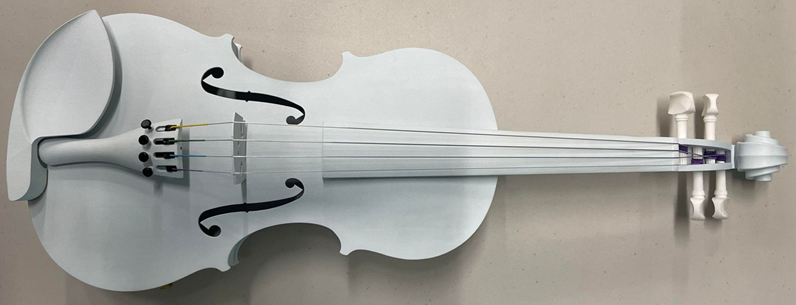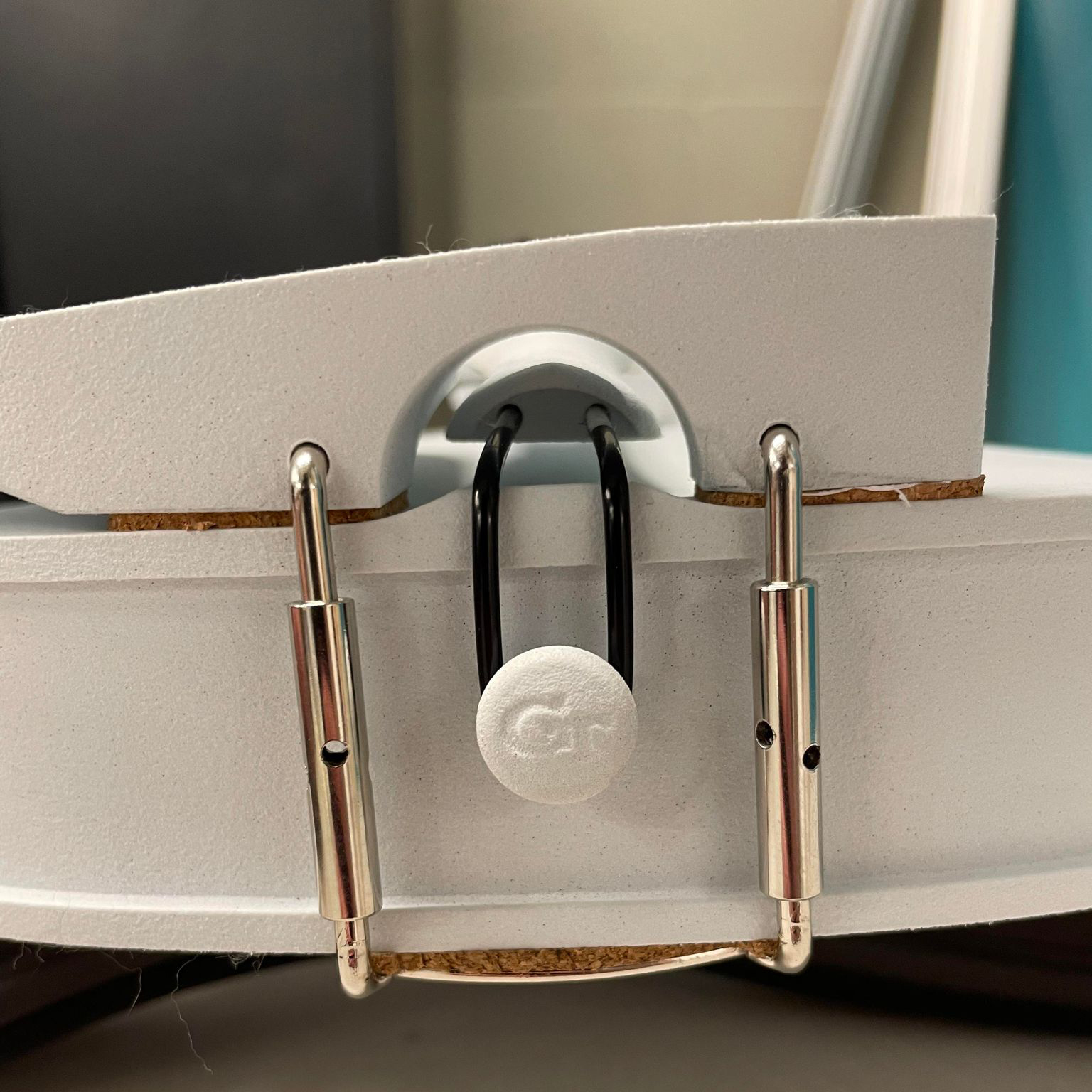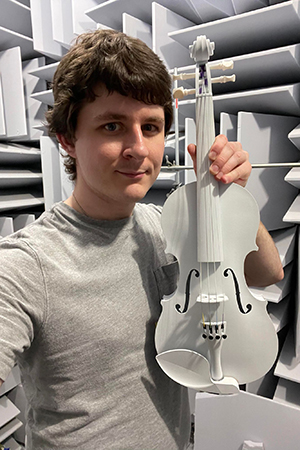January 22, 2025
By Mikey Fuller
Merging a love for engineering with a lifelong passion for music led Kevin Kamperman, a graduate student in the George W. Woodruff School of Mechanical Engineering, to fulfill a lifelong dream of filing a patent on a fully functioning acoustic violin made completely from 3D printing.
Kamperman is a research engineer in the Robotics and Autonomous Systems Division (RASD) at the Georgia Tech Research Institute (GTRI). He and a team of Woodruff School students, including William Davis, Inseo Grace Park, Gihane Rachid, and Lars Worlund, designed and fabricated the violin as a final project in Woodruff Professor Carolyn Seepersad’s additive manufacturing (AM) class last spring.
The research was provisionally filed with the U.S. Patent and Trademark Office in December.
“Seeing this dream become a reality is deeply fulfilling,” Kamperman said. “I believe this invention has the potential not only to be practical but also to bring joy to those who might one day use it to create music. Knowing that something I contributed to could inspire creativity in others is incredibly rewarding.”
Kamperman plays many instruments including the viola, guitar, piano, and violin, which he first started playing when he was seven years old under his tutor Robbie Bowie, who helped him prepare for playing in his school’s orchestras as well as the Georgia Youth Symphony Orchestra.
The idea for the 3D printed violin came from Kamperman’s two personal passions: art and engineering. Inspired by Frank Wilczek’s “A Beautiful Question: Finding Nature's Deep Design,” Kamperman wanted to make something beautiful of his own.
To assist in fabricating the violin, Kamperman and his teammates utilized the advanced powder-based 3D printing equipment of Endeavor 3D, an AM solutions company in Douglasville, Georgia.
The intent of the acoustic AM violin design was to replicate both the sound and feel of a traditional wooden instrument using only AM materials and methods. AM replaces the labor-intensive processes inherent to wood-based instruments while lowering monetary costs.
The design followed a two-stage methodology: MK-I, which closely resembled a traditional wooden violin, and MK-II, which adapted that design for AM. The main challenge was accounting for the material differences between traditional hardwoods and the multi-jet fusion (MJF) powder used for the MK-II prototype. Iterative stress and modal simulations were used to predict and optimize the strength and acoustic performance of the prototype before fabrication.
The team ultimately selected MJF as the AM process for the favorable material properties of the PA 12 (nylon) and its ability to produce complex geometries – like a violin body – without the need to break up those bodies or use support structures.

They collected data from various performance conditions in an anechoic chamber at GTRI with the MJF violin alongside a mid-priced wooden instrument and a high-priced wooden one for comparison.
Dünnwald Parameters were used to qualitatively describe the sound from the measured frequency spectra, with the polymer violin ranking highest for warmth, natality, and brilliance. These findings aligned with qualitative assessments from test violinists, who praised the warmth of the D and G strings but described the A and upper E strings as slightly nasal and less brilliant. A loudness test revealed the polymer violin produced sound slightly quieter than its wooden counterparts.
What’s so exciting about the work, Seepersad said, is the giant leap the team made towards changing the world of innovation and manufacturing for society at large. “By carefully engineering the architecture of the violin itself to match the resonances of a concert violin and adapting it to fit the capabilities and limitations of the powder-based 3D printing technology, they’ve designed and built a truly remarkable instrument."
When the team realized that the machines on campus couldn’t handle the volume needed for the build, Seepersad reached out to Endeavor 3D, which provided parts for the team pro-bono.
Janet Dickinson, Chief Operating Officer at Endeavor 3D, said their vision is to support the next generation of designers and engineers with cutting-edge technologies, materials, and solutions.
While working with Seepersad and her students, Dickinson said they were able to witness first-hand that the students were willing to go beyond conventional designs and ideas.
“We will always support that type of enthusiasm and creativity and will continue to work together with Georgia Tech and the local community to do so,” Dickinson said. “It’s inspirational to see what the next generation of engineers are capable of designing and producing. Kevin and his team did incredible work with the violin and we applaud them for taking action to protect and professionalize that accomplishment.”
Kamperman said Endeavor 3D's support was instrumental in helping them overcome this challenge, allowing the project to stay on track and ensuring a high-quality prototype.
Making music and arts more accessible, affordable, and inclusive for everyday people is what excites Kamperman most about emerging technologies such as this. He hopes combining the precision of 3D printing with the artistry of instrument-making can break down barriers for musicians and revolutionize traditional craftsmanship.


